Mitral regurgitation electrocardiogram
| Resident Survival Guide |
| File:Critical Pathways.gif |
|
Mitral Regurgitation Microchapters |
|
Diagnosis |
|---|
|
Treatment |
|
Case Studies |
|
Mitral regurgitation electrocardiogram On the Web |
|
American Roentgen Ray Society Images of Mitral regurgitation electrocardiogram |
|
Risk calculators and risk factors for Mitral regurgitation electrocardiogram |
Editor-In-Chief: C. Michael Gibson, M.S., M.D. [1]; Associate Editor(s)-in-Chief: Mohammed A. Sbeih, M.D.[2].
Overview
In severe cases of mitral regurgitation, signs of left ventricular hypertrophy with strain, left atrial enlargement, and pulmonary hypertension may be observed on the resting electrocardiogram. Chronic mitral regurgitation is associated with an increased risk for atrial fibrillation.
Electrocardiogram
Left Atrial Enlargement
Left atrial enlargement produces a broad, bifid P wave in lead II (P mitrale) and enlarges the terminal negative portion of the P wave in VI.
In lead II following may be seen:

In lead V1, the following may be seen:
- Biphasic P wave with terminal negative portion > 40 ms duration
- Biphasic P wave with terminal negative portion > 1mm deep

Left Ventricular Enlargement
Pulmonary Hypertension
Atrial Fibrillation
Atrial fibrillation is commonly seen with mitral regurgitation: This is identified as an irregularly irregular rhythm with absence P waves.
Below is an ECG in mitral regurgitation. Note the evidence of left atrial enlargement in lead V1:
